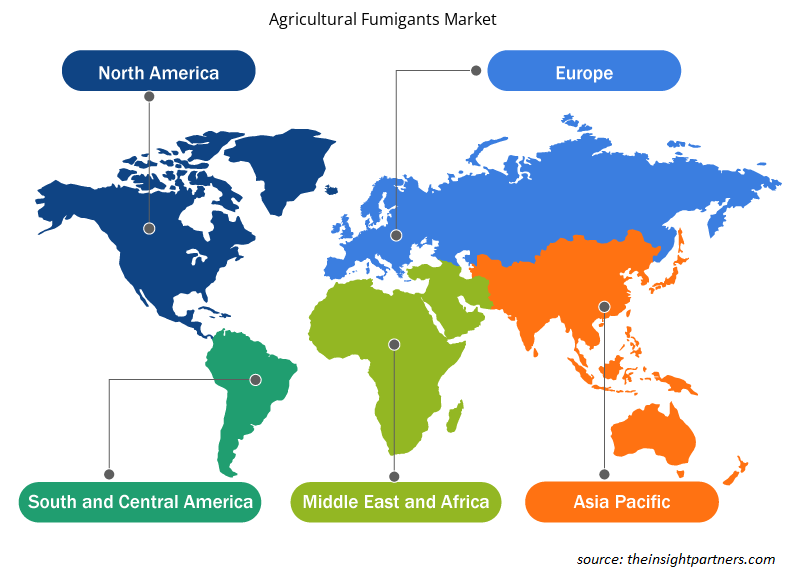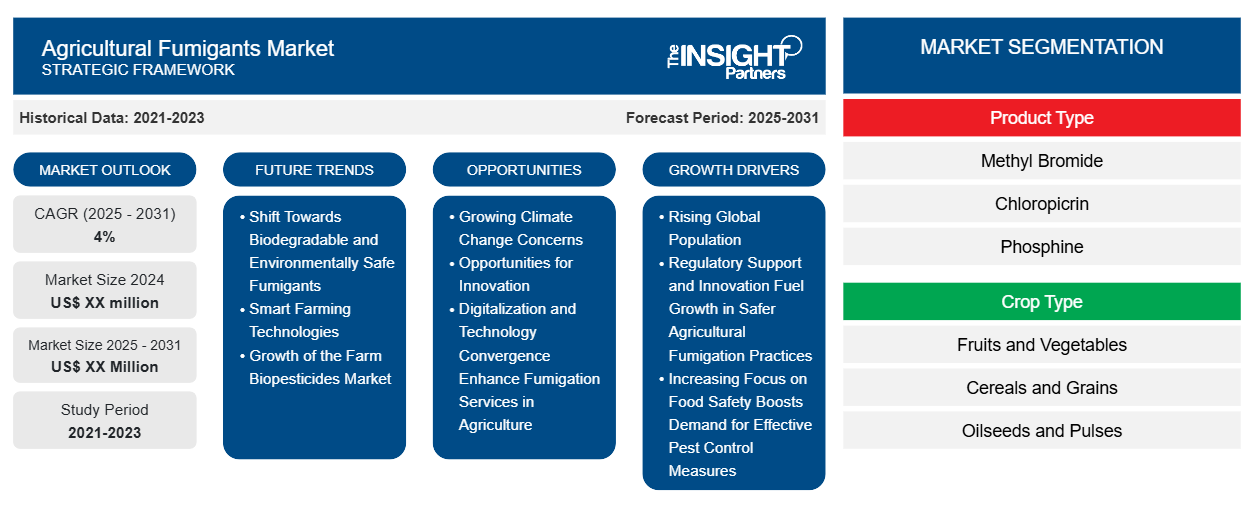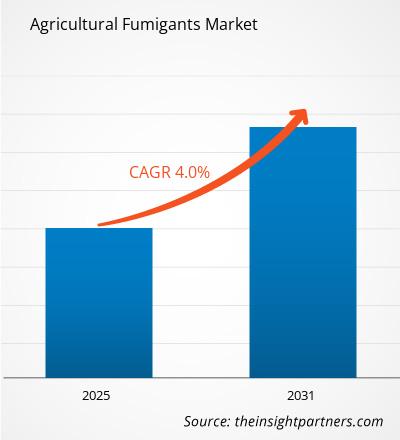Se espera que el mercado de fumigantes agrícolas registre una CAGR del 4% entre 2023 y 2031, con un tamaño de mercado que se expandirá de US$ XX millones en 2023 a US$ XX millones en 2031.
El informe de mercado de fumigantes agrícolas está segmentado por tipo de producto (bromuro de metilo, cloropicrina, fosfina, metam sodio, 1 3-dicloropropeno y otros). El mercado está segmentado en función del tipo de cultivo (frutas y verduras, cereales y granos, semillas oleaginosas y legumbres, y otros). El mercado está segmentado en función de la aplicación (suelo, almacén y otros). El análisis global se desglosa aún más a nivel regional y de los principales países. El tamaño del mercado y el pronóstico a nivel global, regional y de país para todos los segmentos clave del mercado están cubiertos bajo el alcance. El informe ofrece el valor en USD para el análisis, los segmentos, las regiones y los países anteriores. El informe cubre las tendencias del mercado, así como la dinámica del mercado, como los impulsores, las restricciones y las oportunidades clave. El informe también cubre el panorama de la industria y el análisis de la competencia que cubre la concentración del mercado, el análisis del mapa de calor, los actores destacados y los desarrollos recientes en el mercado.
Propósito del Informe
El informe sobre el mercado de fumigantes agrícolas de The Insight Partners tiene como objetivo describir el panorama actual y el crecimiento futuro, los principales factores impulsores, los desafíos y las oportunidades. Esto proporcionará información a diversas partes interesadas del negocio, como:
- Proveedores/fabricantes de tecnología: Para comprender la dinámica cambiante del mercado y conocer las oportunidades potenciales de crecimiento, lo que les permitirá tomar decisiones estratégicas informadas.
- Inversionistas: Realizar un análisis exhaustivo de tendencias sobre la tasa de crecimiento del mercado, las proyecciones financieras del mercado y las oportunidades que existen en toda la cadena de valor.
- Órganos reguladores: Regular las políticas y vigilar las actividades del mercado con el objetivo de minimizar los abusos, preservar la confianza de los inversores y defender la integridad y estabilidad del mercado.
Segmentación del mercado de fumigantes agrícolas
Tipo de producto
- Bromuro de metilo
- Cloropicrina
- Fosfina
- Metam sodio
- 1 3-Dicloropropeno
Tipo de cultivo
- Frutas y verduras
- Cereales y Granos
- Semillas oleaginosas y legumbres
Solicitud
- Suelo
- Depósito
Geografía
- América del norte
- Europa
- Asia-Pacífico
- América del Sur y Central
- Oriente Medio y África
Geografía
- América del norte
- Europa
- Asia-Pacífico
- América del Sur y Central
- Oriente Medio y África
Personalice este informe según sus necesidades
Obtendrá personalización en cualquier informe, sin cargo, incluidas partes de este informe o análisis a nivel de país, paquete de datos de Excel, así como también grandes ofertas y descuentos para empresas emergentes y universidades.
- Obtenga las principales tendencias clave del mercado de este informe.Esta muestra GRATUITA incluirá análisis de datos, desde tendencias del mercado hasta estimaciones y pronósticos.
Factores impulsores del crecimiento del mercado de fumigantes agrícolas
- Aumento de la población mundial: El aumento de la población mundial exige una mayor producción agrícola. Para hacer frente a este problema, los agricultores también han recurrido a toxinas que eliminan las plagas y enfermedades que, de otro modo, reducirían el rendimiento de los cultivos. El aumento de la productividad mediante mejores técnicas de gestión de plagas es, sin lugar a dudas, la principal razón de este mercado.
- El apoyo normativo y la innovación impulsan el crecimiento de prácticas de fumigación agrícola más seguras: el control de plagas se está convirtiendo en una preocupación prioritaria en la estrategia de seguridad alimentaria de la mayoría de los países. Por ello, han comenzado a promulgar leyes que fomentan el uso de fumigantes agrícolas sin peligro. Las formas más nuevas y mejores de llevar a cabo la fumigación, por ejemplo, los dispositivos que tienen efectos menos nocivos sobre el lodo circundante, respaldan el crecimiento de este mercado.
- La creciente atención a la seguridad alimentaria aumenta la demanda de medidas eficaces de control de plagas: existe una creciente preocupación por la calidad y la seguridad de los productos alimenticios. Como resultado, las medidas eficaces de control de plagas son muy buscadas en el mercado. Los fumigantes ayudan a mantener los granos y cultivos almacenados libres de plagas, promoviendo así la seguridad alimentaria.
Tendencias futuras del mercado de fumigantes agrícolas
- Cambio hacia fumigantes biodegradables y ambientalmente seguros: la industria está ciertamente en camino de adoptar prácticas sustentables en todas sus operaciones. Es muy probable que en el futuro el desarrollo y uso de fumigantes sean biodegradables, menos tóxicos y seguros para el medio ambiente. Estos cambios se han producido como resultado de la regulación gubernamental sobre el uso de fumigantes agrícolas y la tendencia cada vez mayor de la sociedad a considerar los problemas ambientales derivados de la agricultura.
- Tecnologías de agricultura inteligente: Las tecnologías innovadoras de la agricultura inteligente también contribuirán a la gestión de la fumigación en el futuro. El uso de análisis de datos, GPS e IoT permitirá a los agricultores aplicar fumigantes de manera más eficiente al identificar las plagas presentes en el ganado. Esta forma de combatir las plagas de forma explosiva dará como resultado un sistema de gestión integrada de plagas más razonable y económicamente adecuado.
- Crecimiento del mercado de biopesticidas agrícolas: con las crecientes preocupaciones de la población por la salud y el medio ambiente, se estima que el mercado de biopesticidas agrícolas se expandirá. Estos fumigantes basados en compuestos orgánicos volátiles son alternativas más saludables a los pesticidas químicos y son altamente efectivos para el control de plagas, al tiempo que garantizan una disminución de los riesgos ambientales y para la salud, lo que sugiere una probable reestructuración en los sistemas del mercado de fumigantes.
Oportunidades de mercado para fumigantes agrícolas
- Preocupaciones crecientes por el cambio climático: las economías avanzadas, especialmente en continentes como Asia y África, ofrecen inmensas posibilidades. Con las crecientes preocupaciones por el cambio climático, a medida que estas regiones avancen en sus métodos agrícolas y desarrollen métodos para controlar las plagas, habrá una gran necesidad de fumigantes eficientes, lo que representa una buena oportunidad de negocio para los fabricantes.
- Oportunidades para la innovación: Existe un gran potencial de mejora en la formulación y el uso de fumigantes. También se pueden obtener beneficios al invertir en el desarrollo de nuevos productos fumigantes seguros y eficaces, ya que esto creará una ventaja frente a los competidores. Los esfuerzos conjuntos de estos pueden conducir a nuevos desarrollos en las tecnologías de fumigantes.
- La digitalización y la convergencia tecnológica mejoran los servicios de fumigación en la agricultura: el actual proceso de digitalización del sector agrícola ofrece una buena oportunidad para integrar los servicios de fumigación en una plataforma digital. Las empresas ahora pueden utilizar datos y aplicaciones móviles para mejorar la eficiencia y la eficacia de los servicios de fumigación de forma personalizada. Esto se conoce como convergencia tecnológica, donde se crean nuevos negocios y se integran a los clientes de una mejor manera.
Perspectivas regionales del mercado de fumigantes agrícolas
Los analistas de Insight Partners explicaron en detalle las tendencias y los factores regionales que influyen en el mercado de fumigantes agrícolas durante el período de pronóstico. Esta sección también analiza los segmentos y la geografía del mercado de fumigantes agrícolas en América del Norte, Europa, Asia Pacífico, Oriente Medio y África, y América del Sur y Central.

- Obtenga datos regionales específicos para el mercado de fumigantes agrícolas
Alcance del informe de mercado de fumigantes agrícolas
| Atributo del informe | Detalles |
|---|---|
| Tamaño del mercado en 2023 | XX millones de dólares estadounidenses |
| Tamaño del mercado en 2031 | US$ XX millones |
| CAGR global (2023 - 2031) | 4% |
| Datos históricos | 2021-2022 |
| Período de pronóstico | 2024-2031 |
| Segmentos cubiertos | Por tipo de producto
|
| Regiones y países cubiertos | América del norte
|
| Líderes del mercado y perfiles de empresas clave |
|
Densidad de actores del mercado de fumigantes agrícolas: comprensión de su impacto en la dinámica empresarial
El mercado de fumigantes agrícolas está creciendo rápidamente, impulsado por la creciente demanda de los usuarios finales debido a factores como la evolución de las preferencias de los consumidores, los avances tecnológicos y una mayor conciencia de los beneficios del producto. A medida que aumenta la demanda, las empresas amplían sus ofertas, innovan para satisfacer las necesidades de los consumidores y aprovechan las tendencias emergentes, lo que impulsa aún más el crecimiento del mercado.
La densidad de actores del mercado se refiere a la distribución de las empresas o firmas que operan dentro de un mercado o industria en particular. Indica cuántos competidores (actores del mercado) están presentes en un espacio de mercado determinado en relación con su tamaño o valor total de mercado.
Las principales empresas que operan en el mercado de fumigantes agrícolas son:
- ADAMA Ltda.
- Corporación química AMVAC
- Grupo Arkema
- BASF SE
- Isagro SpA
Descargo de responsabilidad : Las empresas enumeradas anteriormente no están clasificadas en ningún orden particular.

- Obtenga una descripción general de los principales actores clave del mercado de fumigantes agrícolas
Puntos de venta clave
- Cobertura integral: el informe cubre de manera integral el análisis de productos, servicios, tipos y usuarios finales del mercado de fumigantes agrícolas, proporcionando un panorama holístico.
- Análisis de expertos: el informe se compila sobre la base de un profundo conocimiento de expertos y analistas de la industria.
- Información actualizada: El informe asegura relevancia comercial debido a su cobertura de información reciente y tendencias de datos.
- Opciones de personalización: este informe se puede personalizar para satisfacer los requisitos específicos del cliente y adaptarse adecuadamente a las estrategias comerciales.
Por lo tanto, el informe de investigación sobre el mercado de fumigantes agrícolas puede ayudar a abrir camino para descifrar y comprender el escenario de la industria y las perspectivas de crecimiento. Si bien puede haber algunas preocupaciones válidas, los beneficios generales de este informe tienden a superar las desventajas.
- Análisis histórico (2 años), año base, pronóstico (7 años) con CAGR
- Análisis PEST y FODA
- Tamaño del mercado Valor/volumen: global, regional, nacional
- Industria y panorama competitivo
- Conjunto de datos de Excel



Report Coverage
Revenue forecast, Company Analysis, Industry landscape, Growth factors, and Trends

Segment Covered
This text is related
to segments covered.

Regional Scope
North America, Europe, Asia Pacific, Middle East & Africa, South & Central America

Country Scope
This text is related
to country scope.
Preguntas frecuentes
Sustainability and eco-friendly solutions is expected to be the key market trends.
Based on geography, Asia Pacific held the largest share of the agricultural fumigants market due to its rapidly growing agriculture industry, rising population, the growing agricultural production.
Based on crop type, the fruits and vegetables segment is expected to witness the fastest growth during the forecast period.
AMVAC Chemical Corporation, Arkema Group, Solvay, DEGESCH America Inc., LANXESS, Nippon Chemical Industrial CO LTD, ISAGRO, Syngenta, TriCal Group Inc., and UPL are the key players operating in the agricultural fumigants market.
The growth in agricultural production is driving the market growth.
The Agricultural Fumigants Market is estimated to witness a CAGR of 4% from 2023 to 2031
1. ADAMA Ltd.
2. AMVAC Chemical Corporation
3. Arkema Group
4. BASF SE
5. Isagro SpA
6. LANXESS AG
7. Nippon Chemical Industrial Co., Ltd.
8. Solvay SA
9. Syngenta AG
10. UPL
The Insight Partners performs research in 4 major stages: Data Collection & Secondary Research, Primary Research, Data Analysis and Data Triangulation & Final Review.
- Data Collection and Secondary Research:
As a market research and consulting firm operating from a decade, we have published and advised several client across the globe. First step for any study will start with an assessment of currently available data and insights from existing reports. Further, historical and current market information is collected from Investor Presentations, Annual Reports, SEC Filings, etc., and other information related to company’s performance and market positioning are gathered from Paid Databases (Factiva, Hoovers, and Reuters) and various other publications available in public domain.
Several associations trade associates, technical forums, institutes, societies and organization are accessed to gain technical as well as market related insights through their publications such as research papers, blogs and press releases related to the studies are referred to get cues about the market. Further, white papers, journals, magazines, and other news articles published in last 3 years are scrutinized and analyzed to understand the current market trends.
- Primary Research:
The primarily interview analysis comprise of data obtained from industry participants interview and answers to survey questions gathered by in-house primary team.
For primary research, interviews are conducted with industry experts/CEOs/Marketing Managers/VPs/Subject Matter Experts from both demand and supply side to get a 360-degree view of the market. The primary team conducts several interviews based on the complexity of the markets to understand the various market trends and dynamics which makes research more credible and precise.
A typical research interview fulfils the following functions:
- Provides first-hand information on the market size, market trends, growth trends, competitive landscape, and outlook
- Validates and strengthens in-house secondary research findings
- Develops the analysis team’s expertise and market understanding
Primary research involves email interactions and telephone interviews for each market, category, segment, and sub-segment across geographies. The participants who typically take part in such a process include, but are not limited to:
- Industry participants: VPs, business development managers, market intelligence managers and national sales managers
- Outside experts: Valuation experts, research analysts and key opinion leaders specializing in the electronics and semiconductor industry.
Below is the breakup of our primary respondents by company, designation, and region:

Once we receive the confirmation from primary research sources or primary respondents, we finalize the base year market estimation and forecast the data as per the macroeconomic and microeconomic factors assessed during data collection.
- Data Analysis:
Once data is validated through both secondary as well as primary respondents, we finalize the market estimations by hypothesis formulation and factor analysis at regional and country level.
- Macro-Economic Factor Analysis:
We analyse macroeconomic indicators such the gross domestic product (GDP), increase in the demand for goods and services across industries, technological advancement, regional economic growth, governmental policies, the influence of COVID-19, PEST analysis, and other aspects. This analysis aids in setting benchmarks for various nations/regions and approximating market splits. Additionally, the general trend of the aforementioned components aid in determining the market's development possibilities.
- Country Level Data:
Various factors that are especially aligned to the country are taken into account to determine the market size for a certain area and country, including the presence of vendors, such as headquarters and offices, the country's GDP, demand patterns, and industry growth. To comprehend the market dynamics for the nation, a number of growth variables, inhibitors, application areas, and current market trends are researched. The aforementioned elements aid in determining the country's overall market's growth potential.
- Company Profile:
The “Table of Contents” is formulated by listing and analyzing more than 25 - 30 companies operating in the market ecosystem across geographies. However, we profile only 10 companies as a standard practice in our syndicate reports. These 10 companies comprise leading, emerging, and regional players. Nonetheless, our analysis is not restricted to the 10 listed companies, we also analyze other companies present in the market to develop a holistic view and understand the prevailing trends. The “Company Profiles” section in the report covers key facts, business description, products & services, financial information, SWOT analysis, and key developments. The financial information presented is extracted from the annual reports and official documents of the publicly listed companies. Upon collecting the information for the sections of respective companies, we verify them via various primary sources and then compile the data in respective company profiles. The company level information helps us in deriving the base number as well as in forecasting the market size.
- Developing Base Number:
Aggregation of sales statistics (2020-2022) and macro-economic factor, and other secondary and primary research insights are utilized to arrive at base number and related market shares for 2022. The data gaps are identified in this step and relevant market data is analyzed, collected from paid primary interviews or databases. On finalizing the base year market size, forecasts are developed on the basis of macro-economic, industry and market growth factors and company level analysis.
- Data Triangulation and Final Review:
The market findings and base year market size calculations are validated from supply as well as demand side. Demand side validations are based on macro-economic factor analysis and benchmarks for respective regions and countries. In case of supply side validations, revenues of major companies are estimated (in case not available) based on industry benchmark, approximate number of employees, product portfolio, and primary interviews revenues are gathered. Further revenue from target product/service segment is assessed to avoid overshooting of market statistics. In case of heavy deviations between supply and demand side values, all thes steps are repeated to achieve synchronization.
We follow an iterative model, wherein we share our research findings with Subject Matter Experts (SME’s) and Key Opinion Leaders (KOLs) until consensus view of the market is not formulated – this model negates any drastic deviation in the opinions of experts. Only validated and universally acceptable research findings are quoted in our reports.
We have important check points that we use to validate our research findings – which we call – data triangulation, where we validate the information, we generate from secondary sources with primary interviews and then we re-validate with our internal data bases and Subject matter experts. This comprehensive model enables us to deliver high quality, reliable data in shortest possible time.


 Obtenga una muestra gratuita de este informe
Obtenga una muestra gratuita de este informe